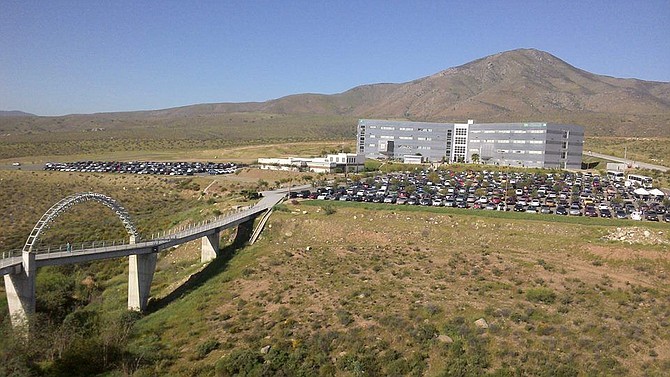 Facebook
Facebook
 X
X
 Instagram
Instagram
 TikTok
TikTok
 Youtube
Youtube

Baja California’s Autonomous University campus at Valle de las Palmas is located 29 miles east of Tijuana’s downtown. 5355 students, mostly from Tijuana and Tecate, make their way to Valle de las Palmas despite the shortage of public transportation.
Some of them travel three hours to get there for classes. Psychology student Eduardo Mendoza is one of them. He lives in the Playas de Tijuana neighborhood. To get there he take three means of transportation: from Playas to downtown TJ, from downtown to El Refugio neighborhood on the outskirts of the city, and then to Valle de las Palmas.
“My first class starts at 8 o’clock. I need to wake up three hours before and I barely make it. Before the pandemic, there was a bus coming out from downtown straight to the campus. Now there are fewer buses available, and it is worse coming back home. I luckily have a professor that takes me and some other friends back close to downtown. But I've heard about students who had to walk kilometers until someone randomly gave them a ride back to the city outskirts”.
The municipal government has tried to implement a transport system to offer students a route.
Carlos Rodriguez who’s studying in Valle de las Palmas, realized this issue during his first semester and worked during the pandemic and virtual classes to buy a car. He’s helping out classmates by sharing his car with them. He noted that this is a way to support each other because they share gas expenses.
“There’s a Facebook page for rides. People post their routes and the empty spaces in their cars. Others don’t even post, just go with their cars to the bus station in El Refugio, park for a few minutes and raise their hands. If you have four empty spaces, you lift four fingers. Most of them take your offer and hop in but some others don’t because, you know, the whole insecurity issue.”
Rodriguez stated that the problem with the lack of transport is the way back, not because of insecurity or getting robbed, but the wildlife in this desert area. Tarantulas, snakes, and coyotes come out at night. The closest neighborhood is about two and a half miles away from the campus, on a road without public lighting.
Verenice Valtierra has an old school bus from the U.S. and uses it to offer rides and charge 10 pesos to each student. She has to deal with transportaion controllers. What she is doing is considered irregular and can bring a fine from the municipal transport department. “It is a way to help out students and get some money now that the pandemic has hit us all badly.”
Transport services like Alitisa, which has a concession for that route, report a lack of drivers for their units.


Baja California’s Autonomous University campus at Valle de las Palmas is located 29 miles east of Tijuana’s downtown. 5355 students, mostly from Tijuana and Tecate, make their way to Valle de las Palmas despite the shortage of public transportation.
Some of them travel three hours to get there for classes. Psychology student Eduardo Mendoza is one of them. He lives in the Playas de Tijuana neighborhood. To get there he take three means of transportation: from Playas to downtown TJ, from downtown to El Refugio neighborhood on the outskirts of the city, and then to Valle de las Palmas.
“My first class starts at 8 o’clock. I need to wake up three hours before and I barely make it. Before the pandemic, there was a bus coming out from downtown straight to the campus. Now there are fewer buses available, and it is worse coming back home. I luckily have a professor that takes me and some other friends back close to downtown. But I've heard about students who had to walk kilometers until someone randomly gave them a ride back to the city outskirts”.
The municipal government has tried to implement a transport system to offer students a route.
Carlos Rodriguez who’s studying in Valle de las Palmas, realized this issue during his first semester and worked during the pandemic and virtual classes to buy a car. He’s helping out classmates by sharing his car with them. He noted that this is a way to support each other because they share gas expenses.
“There’s a Facebook page for rides. People post their routes and the empty spaces in their cars. Others don’t even post, just go with their cars to the bus station in El Refugio, park for a few minutes and raise their hands. If you have four empty spaces, you lift four fingers. Most of them take your offer and hop in but some others don’t because, you know, the whole insecurity issue.”
Rodriguez stated that the problem with the lack of transport is the way back, not because of insecurity or getting robbed, but the wildlife in this desert area. Tarantulas, snakes, and coyotes come out at night. The closest neighborhood is about two and a half miles away from the campus, on a road without public lighting.
Verenice Valtierra has an old school bus from the U.S. and uses it to offer rides and charge 10 pesos to each student. She has to deal with transportaion controllers. What she is doing is considered irregular and can bring a fine from the municipal transport department. “It is a way to help out students and get some money now that the pandemic has hit us all badly.”
Transport services like Alitisa, which has a concession for that route, report a lack of drivers for their units.
Comments